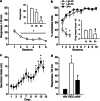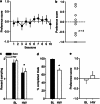Extended heroin access increases heroin choices over a potent nondrug alternative
- PMID: 23322185
- PMCID: PMC3656363
- DOI: 10.1038/npp.2013.17
Extended heroin access increases heroin choices over a potent nondrug alternative
Abstract
Epidemiological research shows that the proportion of drug users who become addicted to heroin is higher than to cocaine. Here we tested whether this difference could be due to a difference in the addiction liability between the two drugs. Addiction liability was assessed under a discrete-trials choice procedure by measuring the proportion of rats that prefer the drug over a potent alternative reward (ie, water sweetened with saccharin). Previous research on choice between self-administration of i.v. cocaine or sweet water showed that the proportion of cocaine-preferring rats remains relatively low and invariable (ie, 15%), even after extended drug access and regardless of past drug consumption (ie, total drug use before choice testing). By contrast, the present study shows that under similar choice conditions, the proportion of heroin-preferring rats considerably increases with extended heroin access (6-9 h per day for several weeks) and with past heroin consumption, from 11 to 51% at the highest past drug consumption level. At this level, the proportion of drug-preferring rats was about three times higher with heroin than with cocaine (51% vs 15%). This increase in the rate of heroin preference after extended heroin access persisted even after recovery from acute heroin withdrawal. Overall, these findings show that choice procedures are uniquely sensitive to different drugs and suggest that heroin is more addictive than cocaine. This higher addiction liability may contribute to explain why more drug users become addicted to heroin than to cocaine in epidemiological studies.
Figures






References
-
- Ahmed SH. Validation crisis in animal models of drug addiction: beyond non-disordered drug use toward drug addiction. Neurosci Biobehav Rev. 2010;35:172–184. - PubMed
-
- Ahmed SH. The science of making drug-addicted animals. Neuroscience. 2012;211:107–125. - PubMed
-
- Ahmed SH, Cador M. Dissociation of psychomotor sensitization from compulsive cocaine consumption. Neuropsychopharmacology. 2006;31:563–571. - PubMed
-
- Ahmed SH, Walker JR, Koob GF. Persistent increase in the motivation to take heroin in rats with a history of drug escalation. Neuropsychopharmacology. 2000;22:413–421. - PubMed
-
- Alderson HL, Robbins TW, Everitt BJ. Heroin self-administration under a second-order schedule of reinforcement: acquisition and maintenance of heroin-seeking behaviour in rats. Psychopharmacology (Berl) 2000;153:120–133. - PubMed
Publication types
MeSH terms
Substances
LinkOut - more resources
Full Text Sources
Other Literature Sources
Miscellaneous

